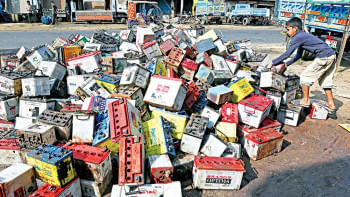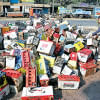Lead pollution: A silent epidemic threatens Bangladesh

Bangladesh is grappling with a silent crisis that threatens its future generations and burdens its economy. Research recently published in The Lancet Planetary Health journal sheds light on the devastating consequences of lead pollution in the country. It reveals a shocking reality: lead pollution is causing a substantial loss of IQ among children and a surge in cardiovascular disease leading to deaths among adults, resulting in a staggering economic toll.
The scale of this crisis cannot be underestimated. Bangladesh stands as the fourth most impacted country by lead pollution in the world, with grave implications for its citizens – particularly children. According to the research, lead pollution is robbing children under the age of five of well over 20 million IQ points, with a significant economic cost of $10,897 million – equivalent to 3.6 percent of the country's annual GDP. The consequences are far-reaching, as childhood lead poisoning increases the risk of decreased intelligence, learning problems and behavioural disorders, undermining the potential of an entire generation.
The research also unveils a disturbing reality for adults. The number of cardiovascular disease-related deaths among adults aged 25 years and older due to lead exposure exceeds previous estimations by four times, amounting to nearly 140,000 lives lost annually. The combined economic cost of these health effects is a staggering $28,633 million, equivalent to six to nine percent of the country's GDP in 2019. These aren't just statistics; they represent personal tragedies, families torn apart, and an economic burden that stifles the potential of an entire nation. The unrelenting march of lead pollution extracts a heavy toll on the heartbeats of Bangladesh.
So where is this insidious lead pollution coming from? Multiple sources contribute to this crisis, including used lead-acid battery recycling in informal settings, leaded paint, aluminium cookware, ceramic food ware, spices, toys, cosmetics, food, electronic waste, fertilisers, cultured fish feed, etc. The improper management of lead-containing elements is responsible for this pollution. Lead exposure can occur through various pathways, including inhalation of lead particles during industrial processes and ingestion of lead-contaminated substances. This includes lead-laden dust, water flowing through lead pipes, and food stored or cooked in lead-glazed or lead-soldered containers.
Given Bangladesh's geographical location within the Ganga-Brahmaputra-Meghna basin, it witnesses a significant water flow through its narrow neck. This hydrological system allows lead to accumulate in the southern region, affecting staple foods such as rice, wheat, maize, fruits, turmeric, fish, and vegetables. Notably, vegetables have been found to be the most contaminated food items.
Children are on the frontline of this silent threat. They absorb significantly more ingested lead than adults, and their curiosity often leads them to ingest lead-coated objects, such as dust or flakes from deteriorating lead-based paint. Tragically, children with the psychological disorder called pica, characterised by a craving for non-food items, are at an even greater risk. Once lead enters the body, it spreads to vital organs like the brain, kidneys, liver and bones, accumulating over time.
Pregnant women can unknowingly expose their developing foetuses to lead when it's released from the bones into the bloodstream. Undernourished children, lacking essential nutrients like calcium and iron, are particularly susceptible to lead's harmful effects. It's crucial to stress that there is no known safe blood lead concentration, as even low levels have been linked to decreased intelligence, behavioural difficulties and learning problems in children.
Lead exposure among children can have catastrophic consequences. At high levels of exposure, it can severely damage the brain and central nervous system, leading to coma, convulsions, and even death. Those who survive may be left with permanent intellectual disabilities and behavioural disorders. Even at lower levels of exposure, where symptoms may not be immediately apparent, lead can wreak havoc across multiple body systems. It can disrupt brain development, causing reduced IQ, attention deficits, increased antisocial behaviour, and diminished educational attainment. Additionally, lead exposure can result in anaemia, hypertension, renal impairment, immunotoxicity, and reproductive organ toxicity. The neurological and behavioural effects of lead poisoning are often irreversible.
Bangladesh has witnessed a significant increase in lead exposure over the past decades, driven by rapid economic growth. Unfortunately, the country's capacity for waste treatment and recycling facilities is limited, resulting in the discharge of untreated waste into agricultural lands, rivers, canals and streams. This has led to persistent lead contamination in both soil and water.
A previous study revealed that areas near industrial and urban zones in Bangladesh experience higher levels of lead deposition in soil, crops, water, air, and vegetables. The use of two and three-stroke engines has historically contributed to atmospheric lead pollution in the country. With numerous informal recycling sites for used lead-acid batteries and lead-acid battery manufacturing sites, there is a substantial threat to public health, particularly in urban and industrial areas where residents face elevated blood lead levels.
Given Bangladesh's geographical location within the Ganga-Brahmaputra-Meghna basin, it witnesses a significant water flow through its narrow neck. This hydrological system allows lead to accumulate in the southern region, affecting staple foods such as rice, wheat, maize, fruits, turmeric, fish, and vegetables. Notably, vegetables have been found to be the most contaminated food items. Lead contamination of the food chain in Bangladesh is a pressing concern, as it can lead to fatal and chronic diseases due to the bioconcentration and biomagnification of lead.
Fortunately, concerned voices in Bangladesh are not staying silent. The Lead-Safe Bangladesh Coalition has emerged as a beacon of hope. Comprising organisations from various sectors, including NGOs, INGOs, UN agencies, researchers, academics, and environmental health experts have outlined a 10-point action plan to tackle the lead pollution crisis. Their recommendations include analysing lead sources, enhancing blood lead level surveillance, increasing monitoring, reviewing policies and enforcing regulations, remediating toxic sites, building capacity among stakeholders, and raising national-level awareness.
These initiatives are essential, but it is equally imperative that the government and policymakers heed these calls for action. Strict regulations and increased investment are paramount to conducting further research and implementing risk reduction strategies effectively. Moreover, public awareness campaigns must also be launched to educate citizens about the dangers of lead exposure, alongside proactive measures to identify and eliminate lead sources in the households.
The consequences of lead pollution may not always be visible, but they are undeniable. The health and well-being of Bangladeshi citizens, especially the children, are at stake. Furthermore, the economic prosperity of the nation is hindered by this preventable crisis. It's high time we recognised that safeguarding the environment is synonymous with safeguarding our future.
Tanvir Ahmad is climate change and public health researcher at International Centre for Diarrhoeal Disease Research, Bangladesh (icddr,b). He can be reached at [email protected].
Views expressed in this article are the author's own.
Follow The Daily Star Opinion on Facebook for the latest opinions, commentaries and analyses by experts and professionals. To contribute your article or letter to The Daily Star Opinion, see our guidelines for submission.

 For all latest news, follow The Daily Star's Google News channel.
For all latest news, follow The Daily Star's Google News channel. 











Comments